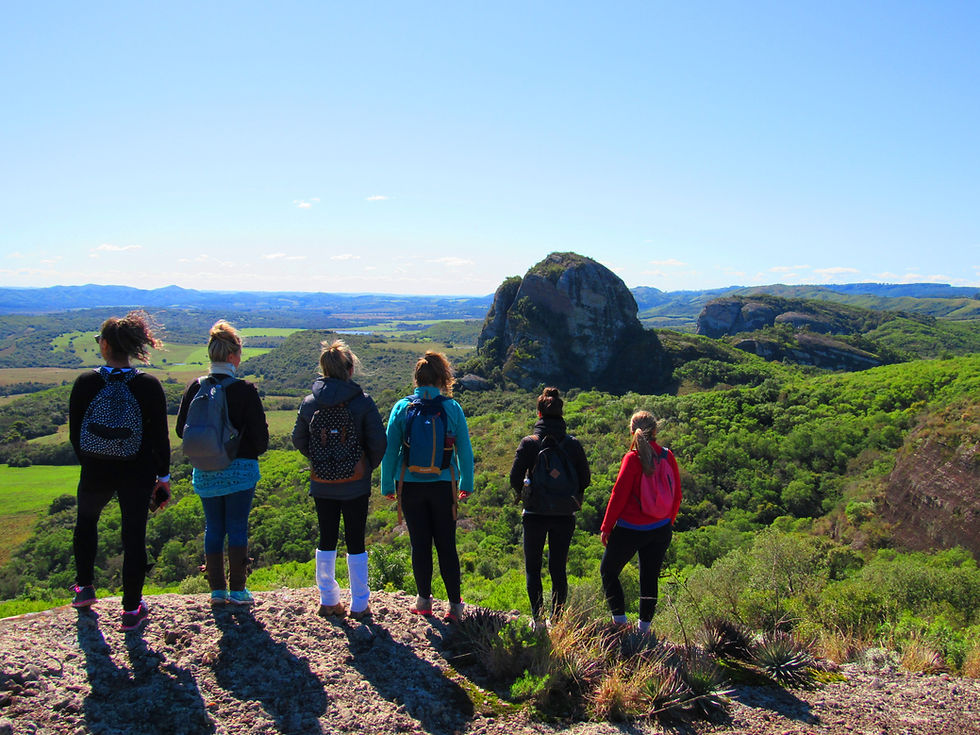Olá, prazer. Somos a

Propomos muita AVENTURA e VIVÊNCIAS inesquecíveis.
Siga a gente e confira as atividades na Pedra do Segredo e em toda região da campanha.
Somos uma empresa focada, em esporte de aventura no rico bioma e geodiversidade do pampa gaúcho, responsável pelo gerenciamento do Parque Natural Pedra do Segredo.




















O Parque da Pedra do Segredo é uma Unidade de Conservação, portanto, possui algumas normas:
-
Trilhas de qualquer natureza, devem ser realizada com calçados apropriados. Perigo de quedas e contato com animais silvestres peçonhentos.
-
Crianças devem estar sempre acompanhada, em presença de um responsável maior de idade. Além de ambientes de risco de altura mesmo com instruções, se garanta a segurança mantendo-se de mãos dadas.
-
Nada pode ser retirado do parque, como amostras vegetais, animais e/ ou minerais.
-
Durante a caminhada deve-se fazer o máximo de silêncio, para que os animais silvestres não sejam prejudicados. Os mesmos já estão sendo visualizados em trilhas com os turistas, desde pequeno até grande porte.
-
É proibido fumar e ingerir bebidas alcoólicas nas trilhas.
-
É proibida a entrada de animais domésticos.
O Parque oferece:
-
Áreas Multi Camping
-
Banheiros M e F com chuveiro quente
-
Wifi
-
Estrutura coberta com churrasqueira
-
Áreas de lazer e conforto
-
Trilhas com guias e autoguiadas
-
Vias de escalada
-
Descidas de rapel
-
Eventos Culturais
-
Produtos Personalizados
 Noturna |  Pedra do Segredo |
|---|---|
 Área Camping 1 |  Riacho |
 Área de descanso |  Área camping 2 |
 Banheiros e Cozinha |  Rapel |
 Cavernas |  Cozinha |
 Eventos Culturais |  Complexo de Trilhas |
Estrutura do Parque
Valor ingresso
Crianças até 5 anos: Isento
Crianças de 5 anos a 14 anos: R$ 5,00
Adultos: R$ 10,00
Camping: R$ 20,00 primeiro dia + R$ 10,00
Clique aqui para conhecer nossos pacotes de trilhas guiadas, rapel e muito mais.
Também fazemos, agendamentos online.

Caçapava do Sul |RS
Welcome and welcome, you are in an area of environmental preservation!






The Pampa Gaúcho is characterized by having a great diversity of species in its flora and fauna. The product of geological and climatic phenomena and activities, the State of Rio Grande do Sul is the result of the composition of different landscapes and has the influence of several ecoregions of the Southern Cone of South America, which favors the occurrence of several endemisms, as stated in the book Cactos from Rio Grande do Sul.
With the loss of natural habitats with the reduction of native forest by human actions, illegal collection of cacti and the hunting of wild animals indicate the disappearance of several species of nature, with this the project consists of inserting society in conscious well-being, preserving and learning sustainability.
Outdoor CATTLE

In Rio Grande do Sul there are about 11 genera and 65 species of cacti, of which 53 are listed under some threat category.
This rich heritage comes from ancient geological periods that portray the current region of the Pampa, as an ancient desert.
Representing approximately 30% of cactus genera and species in Brazil, the alarming situation is mainly due to the loss of natural habitats, caused by the advance of agricultural and forestry areas, in addition to biopiracy (illegal collection) of specimens that exist only in the region .
On your visit to the Pedra do Segredo Municipal Natural Park you can find a variety of cacti along the trail, help us to preserve and recover many endangered species. Remember that it is not allowed to remove plant, animal or mineral samples from the park.
GEODIVERSITY AND PRESERVATION

Caçapava do Sul is the state capital of Geodiversity, being the stage for geoscientific, archaeological, biological and archaeological studies from universities throughout Brazil.
The preservation and awareness of such inheritances often does not correspond proportionally to the speed of social interests. For example, real estate speculation does not limit its actions within the historical, scientific, natural and cultural preservation of the region.
For this reason, the participation and performance of civil society is essential in this process.
PROJETO GEOPARQUE

Geoparks are territories recognized by UNESCO in which the “Memory of the Earth” is preserved and used in a sustainable way to generate development for its community.
This development can occur in tourism, in the creation of products, in gastronomy, in crafts and in all forms of activities that conserve and enhance the geological-geomorphological heritage, such as rocks, minerals, water, soils, reliefs, landscapes and fossils, in association with the culture of the community.
It is a “living” territory, where the time of Earth and the time of humanity meet and mix to celebrate the heritage of what we have received, looking at the present, knowing the past and planning the future.
Reference text: Caçapava Geoparque Projeto

To learn more visit:
